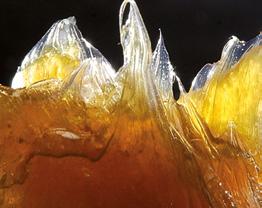
1 minute read
Brief: Lubricating greases

suitable for lifetime lubrication. However, there are limits to what greases can do. Unlike liquid oils, they are not able to dissipate high temperatures or remove contaminants and wear particles from the friction surface.
Lubricating greases are commonly used in situations where a lubricating surface cannot be perfectly supplied with oil. In addition to providing optimal lubrication, in many cases lubricating greases must also seal lubricating surfaces and protect moving parts against wear and contamination. They should attenuate shock loads, and ideally they should be
Lubricating greases are manufactured by stirring a liquid base oil into a suitable thickener. Additives, and in some cases solid lubricants, are mixed in to reduce friction and provide wear protection. Lubricating greases contain 70 to 95% base oil, 3 to 30% thickener, 0 to 10% additives, and at most 10% solid lubricants. As the main ingredient of a grease, the base oil essentially determines its lubricating and performance properties. Mineral oils, synthetic oils, and in some cases vegetable oils are used as base oils.
Thickeners are divided into metallic soaps (such as lithium, sodium, calcium, barium or aluminium) and non-metallic soaps (such as bentonite, polymer resin or silica gel). As carriers for the base oil, they form a cross-linked, sponge-like structure. This structure holds the oil and releases it to the lubricating surface in a controlled manner.
Certain properties of a lubricating grease can be strengthened and/or specifically modified by additives. If a grease has to work under especially severe conditions or have emergency running properties, solid lubricants such as graphite, molybdenum disulphide (MoS2 ) or PTFE (Teflon) are additionally mixed in. A grease containing more than 40% solid lubricants is called a paste.



